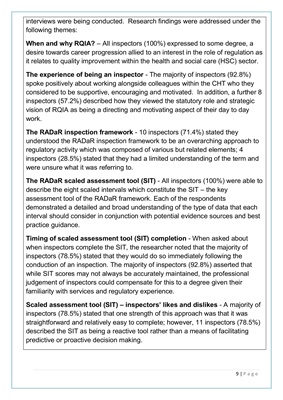
9 | P a g e
interviews were being conducted. Research findings were addressed under the
following themes:
When and why RQIA? - All inspectors (100%) expressed to some degree, a
desire towards career progression allied to an interest in the role of regulation as
it relates to quality improvement within the health and social care (HSC) sector.
The experience of being an inspector - The majority of inspectors (92.8%)
spoke positively about working alongside colleagues within the CHT who they
considered to be supportive, encouraging and motivated. In addition, a further 8
inspectors (57.2%) described how they viewed the statutory role and strategic
vision of RQIA as being a directing and motivating aspect of their day to day
work.
The RADaR inspection framework - 10 inspectors (71.4%) stated they
understood the RADaR inspection framework to be an overarching approach to
regulatory activity which was composed of various but related elements; 4
inspectors (28.5%) stated that they had a limited understanding of the term and
were unsure what it was referring to.
The RADaR scaled assessment tool (SIT) - All inspectors (100%) were able to
describe the eight scaled intervals which constitute the SIT - the key
assessment tool of the RADaR framework. Each of the respondents
demonstrated a detailed and broad understanding of the type of data that each
interval should consider in conjunction with potential evidence sources and best
practice guidance.
Timing of scaled assessment tool (SIT) completion - When asked about
when inspectors complete the SIT, the researcher noted that the majority of
inspectors (78.5%) stated that they would do so immediately following the
conduction of an inspection. The majority of inspectors (92.8%) asserted that
while SIT scores may not always be accurately maintained, the professional
judgement of inspectors could compensate for this to a degree given their
familiarity with services and regulatory experience.
Scaled assessment tool (SIT) - inspectors' likes and dislikes - A majority of
inspectors (78.5%) stated that one strength of this approach was that it was
straightforward and relatively easy to complete; however, 11 inspectors (78.5%)
described the SIT as being a reactive tool rather than a means of facilitating
predictive or proactive decision making.